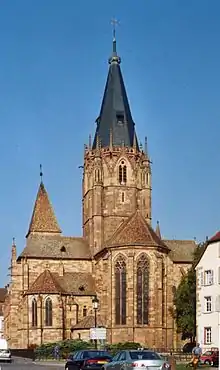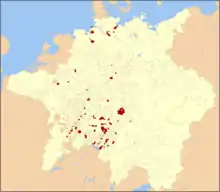Wissembourg
Wissembourg (French pronunciation: [visɑ̃buʁ]; South Franconian: Weisseburch, pronounced [ˈvaɪsəbʊʁç]; German: ![]() Weißenburg ) is a commune in the Bas-Rhin department in Grand Est in northeastern France.
Weißenburg ) is a commune in the Bas-Rhin department in Grand Est in northeastern France.
Wissembourg
Weißenburg | |
|---|---|
.jpg.webp) A general view of Wissembourg | |
 Coat of arms | |
Location of Wissembourg 
| |
 Wissembourg  Wissembourg | |
| Coordinates: 49°02′N 7°57′E | |
| Country | France |
| Region | Grand Est |
| Department | Bas-Rhin |
| Arrondissement | Haguenau-Wissembourg |
| Canton | Wissembourg |
| Intercommunality | Pays de Wissembourg |
| Government | |
| • Mayor (2014-2020) | Christian Gliech |
| Area 1 | 48.18 km2 (18.60 sq mi) |
| Population (2017-01-01)[1] | 7,537 |
| • Density | 160/km2 (410/sq mi) |
| Time zone | UTC+01:00 (CET) |
| • Summer (DST) | UTC+02:00 (CEST) |
| INSEE/Postal code | 67544 /67160 |
| Elevation | 133–527 m (436–1,729 ft) (avg. 160 m or 520 ft) |
| 1 French Land Register data, which excludes lakes, ponds, glaciers > 1 km2 (0.386 sq mi or 247 acres) and river estuaries. | |
It is situated on the little River Lauter close to the border between France and Germany approximately 60 km (37 mi) north of Strasbourg and 35 km (22 mi) west of Karlsruhe. Wissembourg is a sub-prefecture of the department. The name Wissembourg is a Gallicized version of Weißenburg (Weissenburg) in German meaning "white castle". The Latin place-name, sometimes used in ecclesiastical sources, is Sebusium.[2]
The town was annexed by France after 1648 but then incorporated into Germany in 1871. It was returned to France in 1919, but reincorporated back into Germany on 1940. After 1944 it again became French.
History

Weissenburg (later Wissembourg) Abbey, the Benedictine abbey around which the town has grown, was founded in the 7th century, perhaps under the patronage of Dagobert I. The abbey was supported by vast territories. Of the 11th-century buildings constructed under the direction of Abbot Samuel, only the Schartenturm and some moats remain. The town was fortified in the 13th century. The abbey church of Saint-Pierre et Paul erected in the same century under the direction of Abbot Edelin was secularized in the French Revolution and despoiled of its treasures; in 1803 it became the parish church, resulting in the largest parish church of Alsace, only exceeded in size by the cathedral of Strasbourg. At the abbey in the late 9th century the monk Otfried composed a gospel harmony, the first substantial work of verse in German.
In 1354 Emperor Charles IV made it one of the grouping of ten towns called the Décapole that survived annexation by France under Louis XIV in 1678 and was extinguished with the French Revolution. On 25 January 1677 a great fire destroyed many houses and the Hôtel de Ville; its replacement dates from 1741 to 1752. Many early structures were spared: the Maison du Sel (1448), under its Alsatian pitched roof was the first hospital of the town. There are many 15th and 16th-century timber-frame houses, and parts of the walls and gateways of the town. The Maison de Stanislas was the retreat of Stanisław Leszczyński, ex-king of Poland, from 1719 to 1725, when the formal request arrived, 3 April 1725 asking for the hand of his daughter in marriage to Louis XV. The First Battle of Wissembourg took place near the town in 1793.
The “Lines of Wissembourg,” (French: Lignes de Wissembourg) (German: Weißenburger Linien) originally made by Villars in 1706, were famous. They were a line of works extending to Lauterbourg nine miles to the southeast. Like the fortifications of the town, only vestiges remain, although the city wall is still intact for stretches.[3] Austrian General von Wurmser succeeded in briefly capturing the lines in October 1793, but was defeated two months later by General Pichegru of the French Army and forced to retreat, along with the Prussians, across the Rhine River.[4]
Wissembourg formed the setting for the Romantic novel L’ami Fritz (1869) co-written by the team of Erckmann and Chatrian, which provided the material for Mascagni's opera L'Amico Fritz.
Another Battle of Wissembourg took place on 4 August 1870. It was the first battle of the Franco-Prussian War. The Prussians were nominally commanded by the Crown Prince Frederick, but ably directed by his chief of staff, General Leonhard Graf von Blumenthal. The French defeat allowed the Prussian army to move into France. The Geisberg monument commemorates the battle; the town's cemetery holds large numbers of soldiers, including the stately tomb of French general Abel Douay who was killed in combat.[5]
Population
| Year | Pop. | ±% |
|---|---|---|
| 2006 | 8,008 | — |
| 2007 | 7,978 | −0.4% |
| 2008 | 7,880 | −1.2% |
| 2009 | 7,830 | −0.6% |
| 2010 | 7,803 | −0.3% |
| 2011 | 7,780 | −0.3% |
| 2012 | 7,757 | −0.3% |
| 2013 | 7,757 | +0.0% |
| 2014 | 7,738 | −0.2% |
| 2015 | 7,662 | −1.0% |
| 2016 | 7,600 | −0.8% |
Notable people
- Justus Ludwik Decjusz (German: Jost Ludwig Dietz, Latin: Iodocus Ludovicus Decius (1485–1545) notable Polish burgher and diplomat of German origin in 16th-century Kraków.
- Otfrid of Weissenburg
- Jean-Gotthard Grimmer, (1749–1820), pastor at Wissembourg then deputy to the National Convention on 10 ventôse year III (28 February 1795) to replace Philibert Simond.
- Louis Moll, agronomist, born in Wissembourg in 1809 and died in 1880.
- Joseph GuerberJoseph Guerber
- Stanisław Leszczyński, king of Poland from 1704 to 1709, exiled in Wissembourg and lived from 1719 to 1725. The school in the city now bears his name.
- Charles de Foucauld
- Auguste Dreyfus
- Jean Frédéric Wentzel, famous photos of Wissembourg
- Jean-François Kornetzky, football goalkeeper
- Martin Bucer (1491–1551) was a Protestant reformer based in Wissembourg/Strasbourg who influenced Lutheran, Calvinist, and Anglican doctrines and practices.
- Drew Heissler aka Pokey LaFarge, is an American roots musician and songwriter. His family emigrated from Wissembourg/Alsace.
- Jean-Pierre Hubert (1941–2006), a science-fiction writer.
- Julie Velten Favre (1833–1896), philosopher and educator
- Alix Bénézech, actress
Sights

Imperial Abbey of Wissembourg | |||||||||
|---|---|---|---|---|---|---|---|---|---|
| 7th century–1697 | |||||||||
 Coat of arms
| |||||||||
| Status | Imperial Abbey, then Imperial Free City, of the Holy Roman Empire | ||||||||
| Capital | Weißenburg (Wissembourg) | ||||||||
| Government | Theocracy | ||||||||
| Historical era | Middle Ages, Early modern | ||||||||
• Established | 7th century | ||||||||
• Raised to Imperial City | 1306 | ||||||||
• Joined Décapole | 1354 | ||||||||
| 1697 | |||||||||
1793 | |||||||||
| |||||||||
The town, set in a landscape of wheat fields, retains a former Augustinian convent (1279) with its large-scale Gothic church, now the parish of Saints-Pierre-et-Paul; other medieval churches are the lutheran Église Saint-Jean, and the romanesque Église Saint-Ulrich in Altenstadt. The 13th century Dominican church now serves as the cultural center 'La Nef'. The Grenier aux Dîmes (tithe barn) belonging to the Abbey is 18th-century but an ancient foundation. Noteworthy houses are the medieval "Salt house", the Renaissance "House of l'Ami Fritz" and the Baroque City Hall, a work by Joseph Massol.
Notes
- "Populations légales 2017". INSEE. Retrieved 6 January 2020.
- Sebastian Franck, Germaniae Chronicon (Westermair 1538), p. CCCV verso. Jaucourt, L'Encylopédie, 1st ed. (1751), Vol. XVII, pp. 595–96.
- Reynolds, Francis J., ed. (1921). . Collier's New Encyclopedia. New York: P. F. Collier & Son Company.
- www.retrobibliotek.de
- Murray, John (1886). Handbook for North Germany: from the Baltic to the Black Forest, and the Rhine. J.Murray. p. 382. Retrieved 2010-12-03.
References
External links
| Wikimedia Commons has media related to Wissembourg. |
| Wikisource has the text of the 1911 Encyclopædia Britannica article Weissenburg. |
- Tourist information (City of Wissembourg) Accessed 11 May 2014.
- Saints Peter and Paul Church at Structurae
- Virtual tour picture gallery (in French)
- Interactive map of the property of abbey Wissembourg, based on Liber donationum and Liber possessionum, in Traditiones possessionesque Wizenburgenses, edited by Zeuss, Johann Caspar, Speyer 1842


